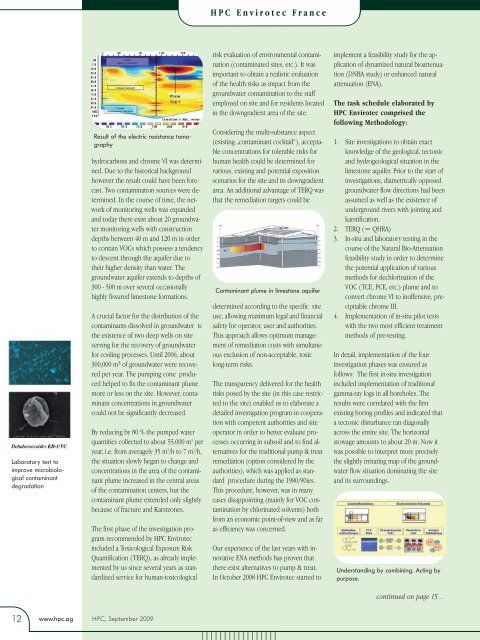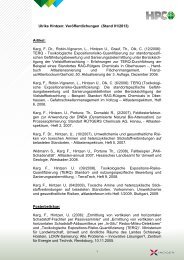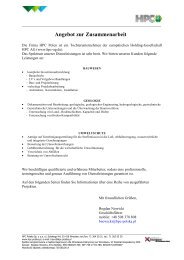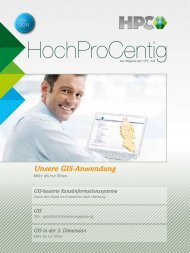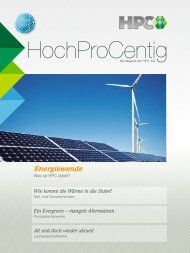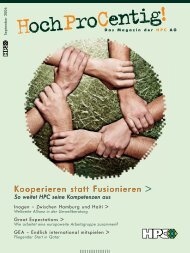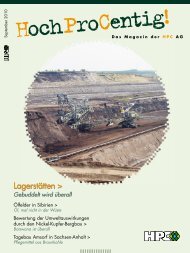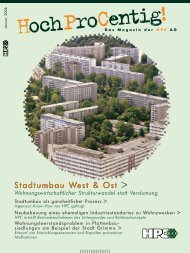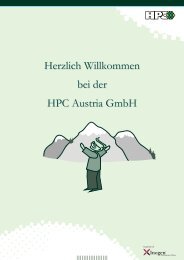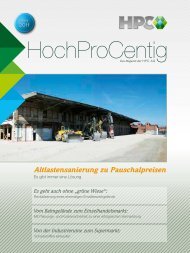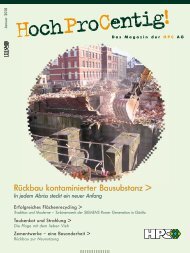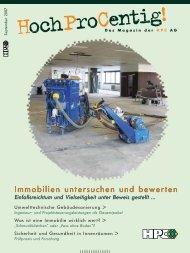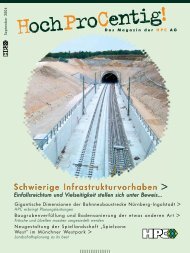France – Greece – Austria – Poland - HPC AG
France – Greece – Austria – Poland - HPC AG
France – Greece – Austria – Poland - HPC AG
You also want an ePaper? Increase the reach of your titles
YUMPU automatically turns print PDFs into web optimized ePapers that Google loves.
Laboratory test to<br />
improve microbiological<br />
contaminant<br />
degradation<br />
Result of the electric resistance tomography<br />
hydrocarbons and chrome VI was determined.<br />
Due to the historical background<br />
however the result could have been forecast.<br />
Two contamination sources were determined.<br />
In the course of time, the network<br />
of monitoring wells was expanded<br />
and today there exist about 20 groundwater<br />
monitoring wells with construction<br />
depths between 40 m and 120 m in order<br />
to contain VOCs which possess a tendency<br />
to descent through the aquifer due to<br />
their higher density than water. The<br />
groundwater aquifer extends to depths of<br />
300 - 500 m over several occasionally<br />
highly fissured limestone formations.<br />
A crucial factor for the distribution of the<br />
contaminants dissolved in groundwater is<br />
the existence of two deep wells on site<br />
serving for the recovery of groundwater<br />
for cooling processes. Until 2006, about<br />
300,000 m 3 of groundwater were recovered<br />
per year. The pumping cone produced<br />
helped to fix the contaminant plume<br />
more or less on the site. However, contaminant<br />
concentrations in groundwater<br />
could not be significantly decreased.<br />
By reducing by 80 % the pumped water<br />
quantities collected to about 55,000 m 3 per<br />
year, i.e. from averagely 35 m 3 /h to 7 m 3 /h,<br />
the situation slowly began to change and<br />
concentrations in the area of the contaminant<br />
plume increased in the central areas<br />
of the contamination centers, but the<br />
contaminant plume extended only slightly<br />
because of fracture and Karstzones.<br />
The first phase of the investigation program<br />
recommended by <strong>HPC</strong> Envirotec<br />
included a Toxicological Exposure Risk<br />
Quantification (TERQ), as already implemented<br />
by us since several years as standardized<br />
service for human-toxicological<br />
12 www.hpc.ag <strong>HPC</strong>, September 2009<br />
<strong>HPC</strong> Envirotec <strong>France</strong><br />
risk evaluation of environmental contamination<br />
(contaminated sites, etc.). It was<br />
important to obtain a realistic evaluation<br />
of the health risks as impact from the<br />
groundwater contamination to the staff<br />
employed on site and for residents located<br />
in the downgradient area of the site.<br />
Considering the multi-substance aspect<br />
(existing „contaminant cocktail“), acceptable<br />
concentrations for tolerable risks for<br />
human health could be determined for<br />
various, existing and potential exposition<br />
scenarios for the site and its downgradient<br />
area. An additional advantage of TERQ was<br />
that the remediation targets could be<br />
Contaminant plume in limestone aquifer<br />
determined according to the specific site<br />
use, allowing maximum legal and financial<br />
safety for operator, user and authorities.<br />
This approach allows optimum management<br />
of remediation costs with simultaneous<br />
exclusion of non-acceptable, toxic<br />
long-term risks.<br />
The transparency delivered for the health<br />
risks posed by the site (in this case restricted<br />
to the site) enabled us to elaborate a<br />
detailed investigation program in cooperation<br />
with competent authorities and site<br />
operator in order to better evaluate processes<br />
occurring in subsoil and to find alternatives<br />
for the traditional pump & treat<br />
remediation (option considered by the<br />
authorities), which was applied as standard<br />
procedure during the 1980/90ies.<br />
This procedure, however, was in many<br />
cases disappointing (mainly for VOC contamination<br />
by chlorinated solvents) both<br />
from an economic point-of-view and as far<br />
as efficiency was concerned.<br />
Our experience of the last years with innovative<br />
ENA methods has proven that<br />
there exist alternatives to pump & treat.<br />
In October 2008 <strong>HPC</strong> Envirotec started to<br />
implement a feasibility study for the application<br />
of dynamized natural bioattenuation<br />
(DNBA study) or enhanced natural<br />
attenuation (ENA).<br />
The task schedule elaborated by<br />
<strong>HPC</strong> Envirotec comprised the<br />
following Methodology:<br />
1. Site investigations to obtain exact<br />
knowledge of the geological, tectonic<br />
and hydrogeological situation in the<br />
limestone aquifer. Prior to the start of<br />
investigations, diametrically opposed<br />
groundwater flow directions had been<br />
assumed as well as the existence of<br />
underground rivers with jointing and<br />
karstification.<br />
2. TERQ (= QHRA)<br />
3. In-situ and laboratory testing in the<br />
course of the Natural Bio-Attenuation<br />
feasibility study in order to determine<br />
the potential application of various<br />
methods for dechlorination of the<br />
VOC (TCE, PCE, etc.) plume and to<br />
convert chrome VI to inoffensive, precipitable<br />
chrome III.<br />
4. Implementation of in-situ pilot tests<br />
with the two most efficient treatment<br />
methods of pre-testing.<br />
In detail, implementation of the four<br />
investigation phases was ensured as<br />
follows: The first in-situ investigation<br />
included implementation of traditional<br />
gamma-ray logs in all boreholes. The<br />
results were correlated with the first<br />
existing boring profiles and indicated that<br />
a tectonic disturbance ran diagonally<br />
across the entire site. The horizontal<br />
stowage amounts to about 20 m. Now it<br />
was possible to interpret more precisely<br />
the slightly irritating map of the groundwater<br />
flow situation dominating the site<br />
and its surroundings.<br />
Understanding by combining. Acting by<br />
purpose.<br />
continued on page 15 ...


